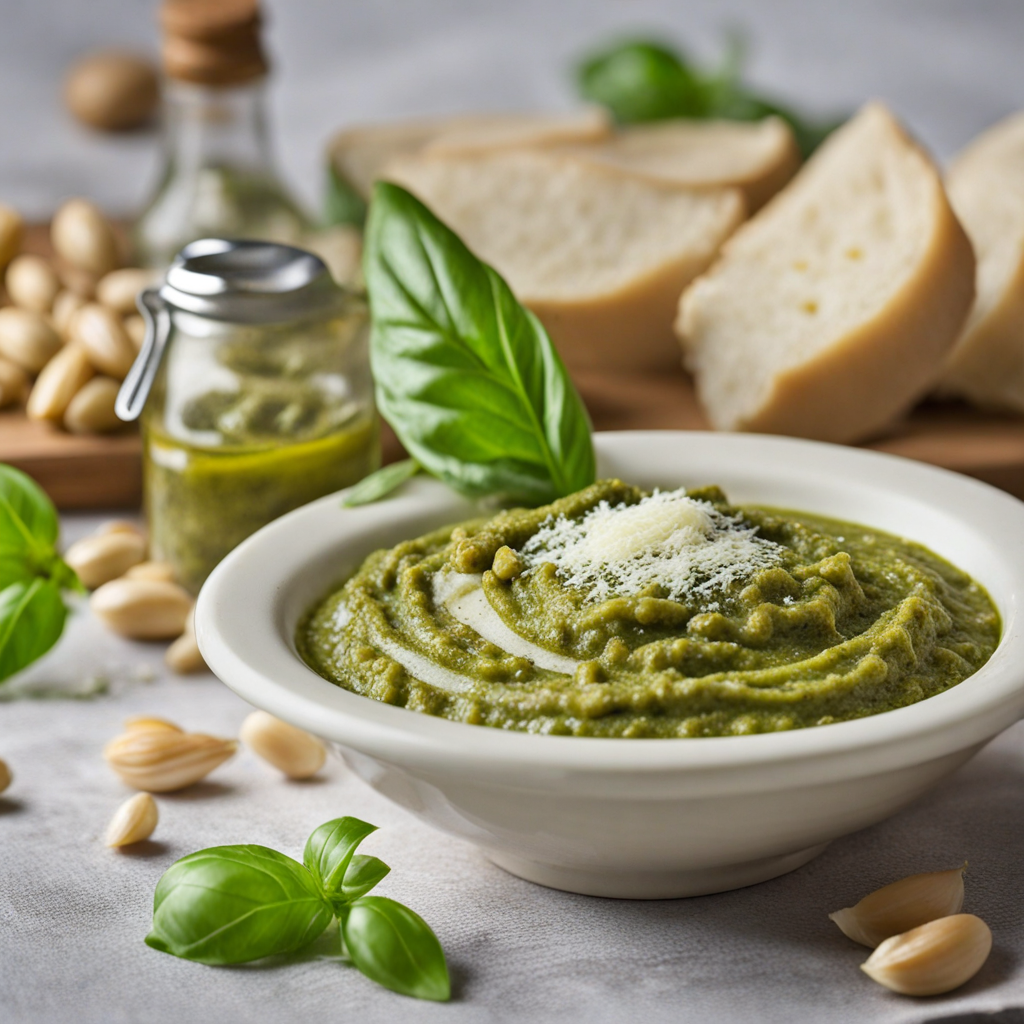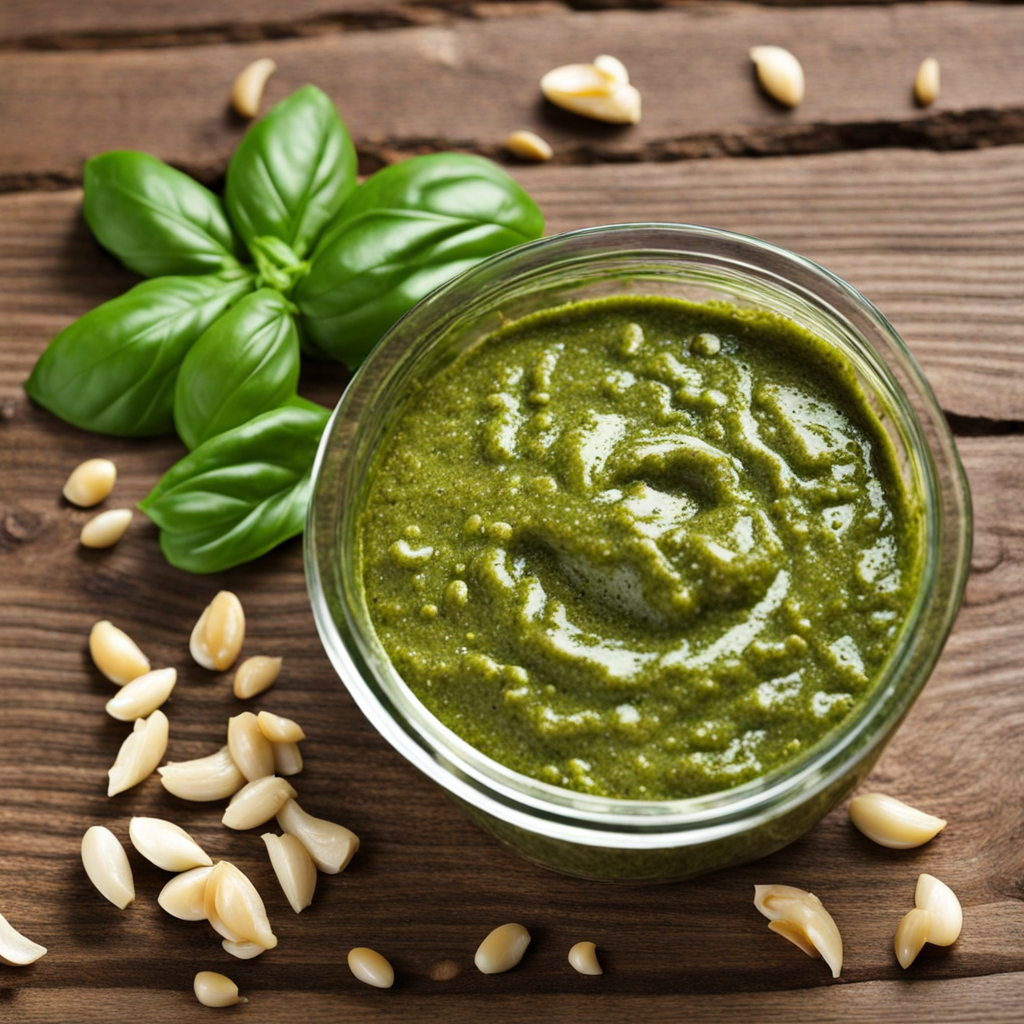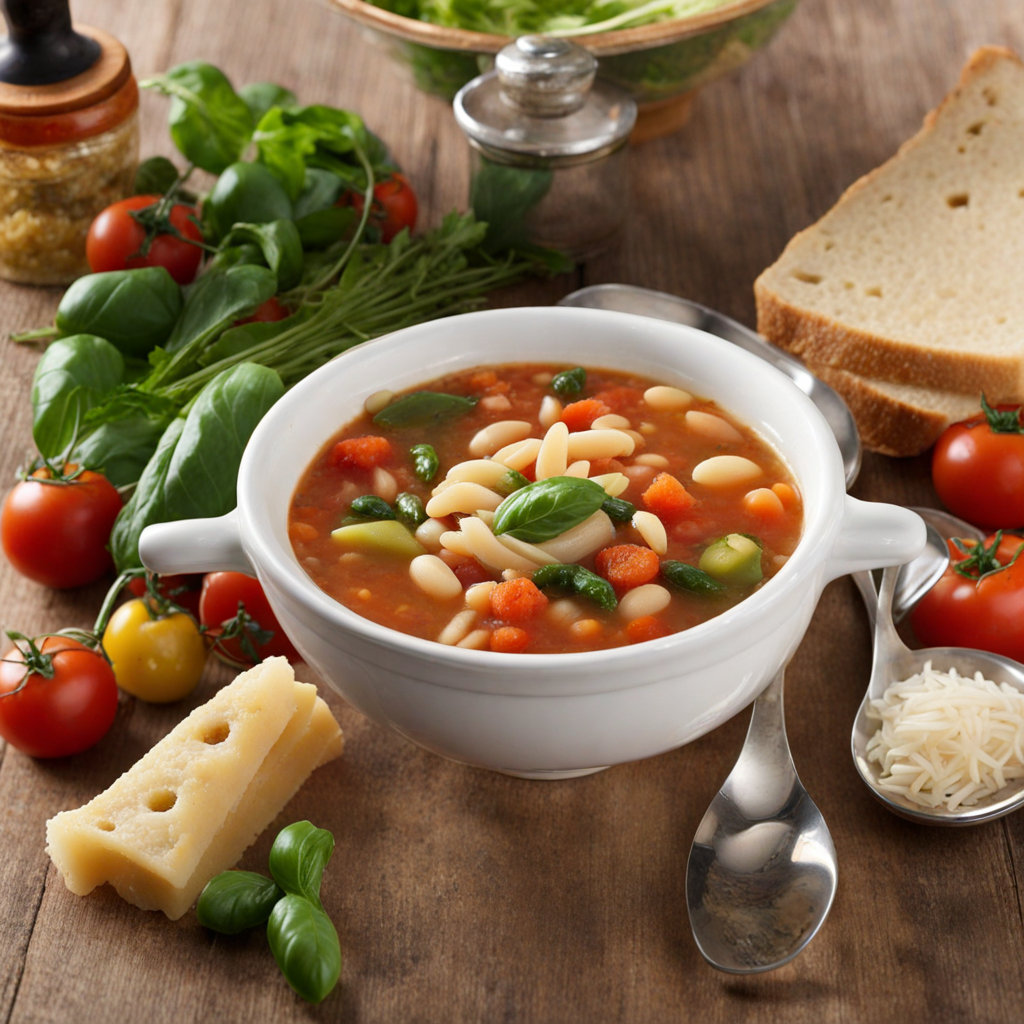Pesto
Pesto is a vibrant, green sauce that hails from the beautiful region of Liguria in Italy, particularly known for its rich culinary traditions. At its core, pesto is made from fresh basil leaves, which impart a fragrant and slightly peppery flavor. The traditional recipe also includes pine nuts, which add a delightful nuttiness and a creamy texture when blended. Olive oil, garlic, and Parmigiano-Reggiano cheese are essential components, creating a harmonious balance that elevates the sauce to a new level of deliciousness. The bright color and aromatic profile of pesto make it a feast for the senses, inviting food lovers to explore its many uses in Italian cuisine. Pesto's versatility is one of its most appealing qualities. While it is famously paired with pasta—most notably trofie or trenette—this sauce can enhance a variety of dishes. Imagine drizzling it over grilled vegetables, stirring it into soups, or using it as a spread on sandwiches and bruschetta. Its bold flavor can transform a simple dish into a gourmet experience, making it a favorite for both home cooks and professional chefs alike. The freshness of the basil combined with the richness of the cheese and the earthiness of the nuts creates a flavor profile that is both complex and comforting. What makes pesto even more exciting is the opportunity for experimentation. While the classic Genovese pesto is beloved, variations abound that incorporate different herbs, nuts, and cheeses. For instance, swapping basil for arugula or spinach can yield a unique twist, while using walnuts or almonds instead of pine nuts adds a different texture and taste. This adaptability allows food enthusiasts to tailor pesto to their personal preferences or regional ingredients, making it a truly global delight that maintains its Italian roots while inviting culinary creativity.
How It Became This Dish
Origins of Pesto Pesto, a vibrant green sauce that has become synonymous with Italian cuisine, traces its roots back to the Liguria region of Italy, particularly the city of Genoa. The name "pesto" derives from the Italian word "pestare," meaning "to pound" or "to crush," which refers to the traditional method of preparation using a mortar and pestle. The earliest recorded mention of a sauce resembling pesto dates back to the 19th century, but its origins likely extend further into the past, with influences from ancient Roman cuisine. The original version of pesto was known as "agliata," a garlic-based sauce made with crushed garlic, walnuts, and oil. This mixture was used as a condiment for various dishes. The incorporation of fresh basil, a staple herb in Mediterranean cooking, marks the evolution toward what we recognize as modern pesto. By the late 19th century, the classic recipe of pesto alla genovese emerged, combining fresh basil leaves, garlic, pine nuts, Parmesan cheese, and extra virgin olive oil, all crushed together to create a smooth, aromatic sauce. \n\n Cultural Significance Pesto is not merely a culinary delight; it embodies the rich cultural heritage of Liguria and the broader Italian tradition. For the people of Genoa, pesto is a symbol of regional pride, representing the area's bountiful produce and artisanal craftsmanship. The ingredients of pesto are reflective of Liguria's landscape: the fragrant basil grows abundantly in the warm coastal climate, while pine nuts and olive oil have been staples of the region's agriculture for centuries. In Ligurian households, pesto is often made from scratch, using a mortar and pestle to ensure the perfect texture and flavor. This method is not just about taste; it is steeped in tradition and a sense of community. The preparation of pesto can be a communal activity, bringing families and friends together to share in the experience of creating something that is deeply tied to their heritage. Furthermore, pesto has become a symbol of the Italian way of life, emphasizing the enjoyment of simple, high-quality ingredients. \n\n Development Over Time As Italian immigrants spread across the globe, so too did the popularity of pesto. By the mid-20th century, pesto began to gain recognition beyond Italy's borders, particularly in the United States and other Western countries. The post-World War II era saw a growing fascination with Mediterranean cuisine, leading to an increased appreciation for fresh herbs and sauces. In the 1980s, the demand for convenience foods surged, giving rise to commercially produced pesto. This shift resulted in a wide variety of pesto sauces available in supermarkets, often deviating from the traditional recipe. While these products provided accessibility, they sometimes lacked the authenticity and freshness of homemade versions. Nevertheless, the proliferation of pesto in ready-to-eat formats allowed for its incorporation into a diverse range of dishes, from pasta to sandwiches and salads. \n\n Modern Interpretations and Variations In recent years, chefs and home cooks alike have embraced creativity in their interpretations of pesto, leading to an explosion of variations that reflect local ingredients and culinary traditions. While the classic basil pesto remains a favorite, alternatives have emerged, featuring ingredients such as sun-dried tomatoes, arugula, cilantro, and even spinach. Nuts other than pine nuts, such as walnuts, almonds, and cashews, are also commonly used, showcasing the adaptability of this beloved sauce. Moreover, the rise of dietary preferences and restrictions has led to the development of vegan and nut-free versions of pesto. Vegan recipes replace cheese with nutritional yeast or other plant-based substitutes, while nut-free variations often utilize seeds, like sunflower or pumpkin seeds, to maintain the sauce's texture and flavor. These adaptations have ensured that pesto remains relevant and accessible to a broader audience, demonstrating the dish's versatility. \n\n Pesto in Contemporary Cuisine Today, pesto is celebrated in both traditional and contemporary cuisine. It is featured in high-end restaurants, where chefs elevate the dish by pairing it with gourmet ingredients like truffle oil or using it as a base for intricate plated presentations. Simultaneously, it retains its place in home kitchens, where it is often regarded as a go-to sauce for quick and flavorful meals. Pesto's versatility allows it to be used in a variety of culinary applications beyond pasta. It serves as a delicious marinade for meats and fish, a vibrant dressing for salads, or a flavorful spread for sandwiches. The increasing popularity of plant-based diets has also led to pesto being used as a dip for vegetables or a flavor enhancer for grain bowls. Its ability to enhance a dish with minimal effort has solidified its status as a staple in kitchens around the world. \n\n Pesto Festivals and Cultural Celebrations The cultural significance of pesto is further highlighted through various festivals held in Liguria, particularly celebrating the harvest of basil and the production of pesto. One of the most notable events is the "Festa del Pesto," held annually in Genoa. During this festival, chefs and enthusiasts come together to showcase their pesto-making skills, often competing for the title of the best pesto. These events not only serve to honor the traditional recipe but also to celebrate the community and the agricultural practices that sustain it. Furthermore, pesto has become a symbol of Italian culinary heritage, often featured in discussions about regional Italian cuisine. The protection of traditional recipes has led to the establishment of guidelines for authentic pesto alla genovese, ensuring that the quality and methods align with its cultural roots. This effort reflects a broader movement to preserve culinary traditions in an increasingly globalized world. \n\n Conclusion As pesto continues to evolve, it remains a beloved culinary treasure that connects people to their heritage and to each other. Its origins in the picturesque region of Liguria tell a story of simplicity, tradition, and community, while its modern adaptations showcase its versatility and global appeal. Whether enjoyed in its classic form or as part of a contemporary dish, pesto stands as a testament to the enduring power of food to transcend borders and bring people together.
You may like
Discover local flavors from Italy







